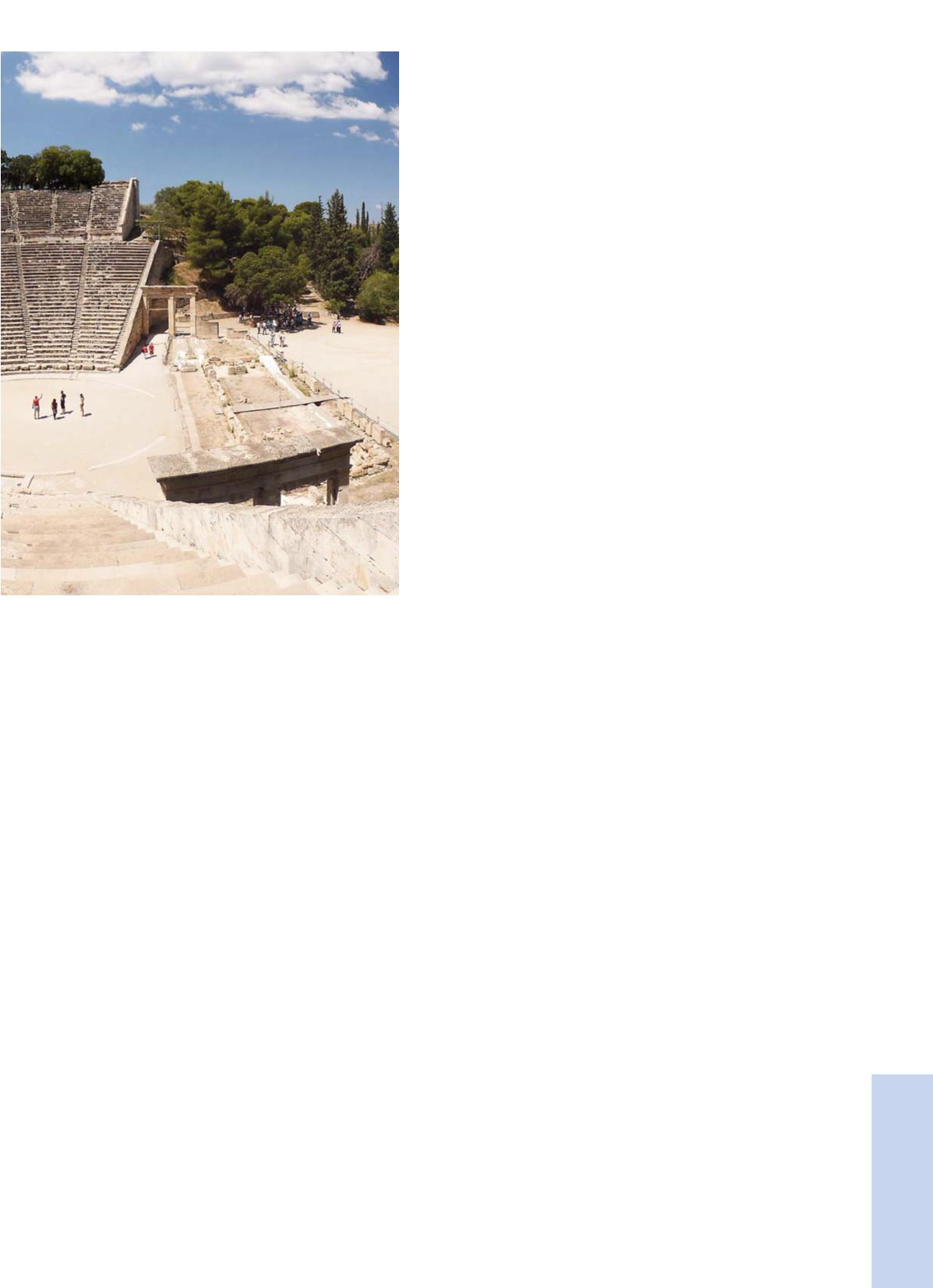
Trade with Greece
117
believed that attending theatrical and other events
was beneficial to the patients’ mental and physical
health.
The ancient theatre of Epidaurus, which is consid-
ered to be the most perfect ancient Greek theatre in
terms of aesthetics and acoustics, as well as the
most symmetrical structure of its kind, was built in
the middle of the 4th century BC. It was designed
by Polykleitos the Younger, an architect and sculp-
tor from Argos and grandson of the synonymous
5th century sculptor, and was the most impressive
monument within the sanctuary.
Contrary to what happened with other Classical or
Hellenistic theatres, this theatre was not renovated
in Roman times and retained its authentic form.
The typical tripartite architectural structure of
ancient Greek theatres is perfectly applied in this
building:
• Its
orchestra
is a perfect circle, with a floor of
hard-pressed earth, encased by a stone perime-
ter. It is 19.5 metres in diameter and surrounded
by an open passage/drain to remove any rain-
water flowing from the
koilon
.
• The reclining part of the theatre is perfectly
adapted to the natural cavity of the northern
slope of mount Kynortio, at an angle of approxi-
mately 26 degrees. It consists of two parts, sep-
arated by a passage: the lower part comprises
34 rows of seats for priests and dignitaries, and
the lower part, which was constructed at a later
stage (mid-2nd century BC), comprises 21 rows
for the general population. The theatre’s capaci-
ty is estimated at 12-13 thousand persons.
• The
skene
was oblong and two-storeyed, was
adjacent to the
orchestra
and closed from one
end to the other the opening of the
koilon
to the
orchestra’s
open side (the side facing the spec-
tators). The entire architecture of the scene of
the Epidaurus theatre shows that it was
designed for the presentation of dramas in the
form that was finalized in Athens during the 5th
century BC.
In the late 4th century CE, as part of the prosecu-
tions launched by the Christian Byzantine emperors
against pagan religions, both the Asclepeion and
the theatre of Epidaurus were permanently closed.
The area was devastated by natural disasters and
human interventions, until the Greek Archaeological
Service started a systematic excavation (1870-
1926) in order to uncover the ancient monuments.
A few years later, in 1938, the first modern perform-
ance of an ancient play (“Electra”, by Sophocles)
was staged in the ancient theatre of Epidaurus. The
performances were later put on hold because of the
Second World War, while the theatre was restored
in the early 1950s and can now accommodate a
large number of spectators. In 1955, the theatre
became the venue of the Epidaurus Festival, which
hosts performances featuring many leading Greek
and foreign actors. Participation in the Festival’s
theatrical and other events is considered to be one
of the greatest recognitions for modern artists.
Today, the Athens and Epidaurus Festival offers a
diverse programme, which covers the entire sum-
mer period, from June to September.
In 1988, the theatre was included, along with the
entire Asclepeion, which is a publicly accessible
archaeological site, in UNESCO’s list of World
Heritage Monuments.
c) Theatre of Delphi
The ancient theatre of Delphi (approximately 160
km to the northwest of Athens), is one of the best
preserved theatres in Greece, is located within the
sacred precinct of Pythian Apollo, and is built on a
steep slope of mount Parnassus. In ancient times
the theatre hosted singing and instrumental music
competitions held as part of various religious cere-
monies in honour of the god Apollo, as well as the-
atrical contests and poetic events.
Built in the 4th century BC, originally from lime-
stone, in 160/159 BC the theatre underwent a
remodelling sponsored by Eumenes II of
Pergamon, which gave it a more monumental form,
Theatre of Epidaurus


